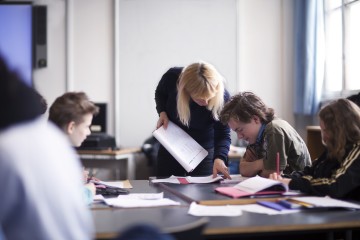
In short, (you guessed it!) by improving acoustics
A masters thesis from last year by Petra Lagerberg and Sebastian Holm at the Royal Institute of Technology, Stockholm KTH examined if an improved acoustic environment in schools can have positive socio-economic effects. Their study shows that an improved sound environment makes classes more efficient and that the total teaching time increases.
“Waiting time” becomes teaching time
When students enter a classroom, it tends to become noisy. If the room has hard floors, walls and ceilings, the sound is reflected and sound levels increase. Naturally, it takes a while for this noise to fade out so that the teacher can start the class. This is lost time that isn’t spent teaching or learning. Petra and Sebastian asked a fifth grade teacher to measure this “waiting time”.
 Sound absorbers were installed during Easter holidays to improve the classroom acoustic conditions.
Sound absorbers were installed during Easter holidays to improve the classroom acoustic conditions.
Afterwards the same measurements were carried out and showed that the “waiting time” had decreased. Meaning more teaching time, more learning and less lost time. In fact, it increased by 15 minutes during a week. In Sweden, this equals 547,5 minutes/class per school year.
Is an improved sound environment a sound investment?
A Swedish colleague, Jonas Christensson, took these findings and made some calculations* in a recent blog post. Basically, he found that the value of an improved sound environment is €2 108/year for a class of 23 students.
Installing sound absorption in a classroom of 50 square metres in order to deal with the common problem mentioned earlier, sound reflections, costs approximately €2 634. This means that you have return on investment after 1.25 year. No more than the blink of an eye in the life of a building.
Some may disagree with the way he’s done the calculations but then it’s also important to remember, as he points out in his post, that this does not take in account the value of an improved work environment for the teachers, nor the possibility for students to gain more knowledge. Knowledge that will ensure the students have better chances of success in school and in life. Therefore Jonas argues that a relatively small investment in the sound environment in classrooms has the potential to create great savings for the society as it could improve educational success and overall inclusion.
The master thesis concludes with the following sentence:
“The observed benefits are considered greater than the investment cost so much so that the installation is recommended to existing school buildings as well as new.”
Read the thesis En effektiv lektion (in Swedish).
More on the importance of good classroom acoustics.
*According to the Swedish Department of Education, in 2014, the cost per student is as follows:
- Teaching (mainly staff costs) €5 230.
- Premises, furniture and equipment €1 898.
- Resources €443.
TOTAL teaching cost (or if you rather, investment) = €7 571/student.
A class with 23 students equals an investment of €7 571 x 23 = €174 133/year.
According to the curriculum, students (year 1-9) should receive 754 teaching hours on average per academic year.
€174 133/754 h = €231/h = an investment of €3,85/minute.
Petra and Sebastian showed that the teaching time increased by 15 min/week.
One academic year is 36,5 weeks long. 15 minutes x 36,5 = 547,5 minutes/academic year. Each minute we invest €3,85 the value of an improved sound environment is;
547,50 min x €3,85/min = €2 108/year for a class of 23 students.

